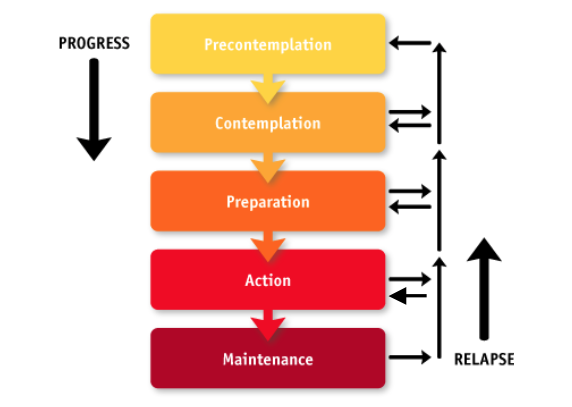Stages of Change
This fact sheet outlines the stages of behavioural change and how to best work with an individual in each stage.
Stages of Change Model
Prochaska and DiClemente's transtheoretical model of behaviour change is a way of understanding an individual's readiness for making behavioural change. The model is helpful for conceptualizing the mental states of individuals at different stages of their change journey and tailoring treatment accordingly. The Stages of Change model below illustrates the stages of this model (precontemplation, contemplation, preparation, action, maintenance).

While many people will experience a relapse, it is possible for a person to sustain change at the maintenance phase. By using this model the therapist can normalise relapse. When someone relapses it is important to help them to pick up the change process at the preparation, action or maintenance phase rather than going all the way back to pre-contemplative or contemplative
phase.
The person learns from each relapse every time they move through the cycle, and (hopefully) grows stronger so the relapse is shorter and less distressing.
Pre-contemplation
Characteristics:
No intention of changing behaviour
Denial/lack of awareness that there is a problem: "Weight is not a concern for me"
Goals:
Help the individual develop a reason for changing
Validate the individual’s experience
Encourage further self- exploration
Leave the door open for future conversations
Techniques:
Validate lack of readiness
Clarify that the decision is theirs
Explain and personalize the risk
Explore potential concerns and re- evaluation of current behaviour
Encourage possibility of change
Scripts:
"I can understand why you feel that way"
“I know you’re an adult and you will be the one to decide if and when you’re ready to gain weight”
“I believe, based on my training and experience that this weight loss is putting you at risk for physical and psychological complications”
“Has your weight loss ever caused you a problem?”
“Everyone who’s addressed an eating issue starts where you are now, by seeing reasons why weight gain might be beneficial to your health and wellbeing.”
Contemplation
Characteristics:
Awareness of problem
Willing to think about change
Ambivalent about change within the next month: ‘Sitting on the fence’
Goals:
Validate the individual’s experience
Encourage evaluation of pros and cons of change
Encourage further self- exploration
Identify and promote new positive outcome expectations
Techniques:
Validate lack of readiness
Encourage evaluation of pros and cons of change
Encourage further self-exploration
Leave the door open for future conversations
Scripts:
"I‘m hearing you’re thinking about weight gain but are not ready to take action now”
“What is one benefit of gaining weight? What is one drawback of gaining weight?”
“Can you have a think about these questions at home and talk to me about it at our next visit?”
“If you feel you’d like to make some changes, we can begin some preparation work”
Preparation
Characteristics:
The individual has had some experience with change: ‘Testing the waters’
Planning to take action to change within the next month
Goals:
Praise the decision to change behaviour
Prioritize behaviour change opportunities
Identify and assist in problem solving
Encourage small initial steps
Encourage identification of social supports
Techniques:
Praise the decision to change
Prioritize behaviour change opportunities
Identify obstacles
Encourage small initial steps
Identify social support
Scripts:
"It’s great you feel good about your decision to make some changes”
“Looking at your eating habits, I think a benefit could come from switching from non- fat milk to whole milk”
“What kind of problems would you expect? How might you deal with them?”
“Which family members or friends can support you as you make this change? How can they support?”
Action
Characteristics:
Actively attempting to change behaviour
These behaviours changes may occur over a 3-6 month period
Goals:
Validate all efforts at behaviour change
Focus on restructuring behavioural cues and social situations supportive of the change process
Bolster self-efficacy for dealing with obstacles
Combat feelings of loss
Techniques:
Restructure cues and social support
Bolster self-efficacy for dealing with obstacles
Reiterate long-term benefits
Scripts:
"Have you successfully altered the behaviour for 1 day to 6 months?”
Maintenance
Characteristics:
Continued commitment to sustaining new behaviour
New behaviours replace old ones
Post 6 months to 5 years
Goals:
Validate progress so far and the potential for sustained change
Plan for follow-up support
Reinforce internal rewards
Discuss the potential for relapse as a normal part of the change process and make a plan to address relapse situations and feelings around relapse
Techniques:
Plan follow-up support
Reinforce internal rewards
Discuss strategies to cope with relapse
Scripts:
"Have you maintained change for a period of 6 months or more?”
Relapse
Characteristics:
Fall back into old patterns of behaviour
Goals:
Validate efforts to resume ʻchangedʼ behaviour
Evaluate trigger for relapse – treat the relapse as a learning experience
Reassess motivation and barriers to sustained change
Identify additional coping strategies/support which may be required
Techniques:
Evaluate triggers for relapse
Reassess motivation and barriers
Plan effective coping strategies
References
- Adapted: UCLA Centre for Human Nutrition http://www.cellinteractive.com/ucla/physcian_ed/